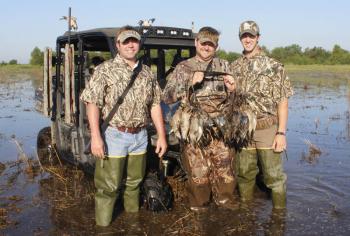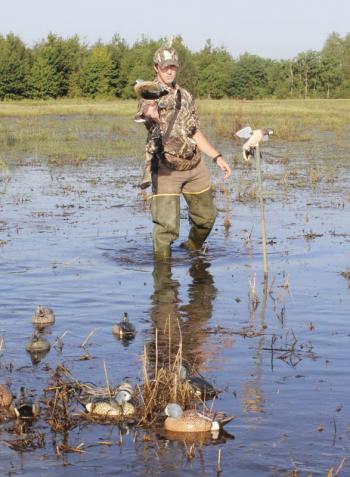Slow start, fast finish for hunters
Migratory bird seasons have opened across the state, and hunters made it rain teal and dove feathers in the Tri-Parish area.
“We hunted Saturday, Sunday and Monday and let them rest on Tuesday,” said Brett Manuel of Eunice as he, Lee Miller, Brett Garcille and Manuel’s black lab Champ hunted teal near Basile during the first week of the season. “We haven’t missed a limit yet.
“We did great for teal last year, but big duck season was slow,” Manuel said. “We limited out pretty much every hunt last for teal season, and they were all blue-winged.”
All three of the men have been hunting since they could walk, and all three are members of Delta Waterfowl. Manuel owns Manco Vegetation Management, Garcille is a lawyer in Eunice and Miller is a physical therapist at Rehab Xcel in Eunice.
The hunters walked out to their spot in the shallow lake about 20 minutes before sunrise and set out the floating decoys and the moving-wing decoys. Once the decoys were set, everyone took their place on stools in a stand of tall grass in the lake. Before the sun even began to rise, the tell tale sound of flapping wings could be heard from ducks moving around the lake.
As shooting time arrived, so did a bit of fog, and a barrage of blasts from the adjacent blind signaled the start of the party. Champ whined, anxious to get to work collecting birds.
While the hunters waited for their first chance to shoot for the day, talk turned to the weather.
“There is no front in sight,” Manuel said. “Everybody I talked to yesterday had a bad day. It’s foggy, and there’s no wind.”
During the next 30 minutes, several small groups of teal passed near the blind as Manuel worked to call them into firing range. Most of the birds barely gave the decoy spread a look before flying off, but a few got close enough for the hunters to pluck off some of the ducks in the flights.
“The later it gets, the better they’ll show up,” Manuel said as he worked with Champ to retrieve the marked birds. “There’s not even a breeze right now to shake the decoys.”
“If we could have shot about four minutes before shooting time, we’d be done,” Garcille said.
As the sun rose higher into the sky, a thick bank of fog rolled in and kept the hunters cool on the warm morning. Shots rang out from another blind and from other areas farther from the lake.
Finally, at around 7:30 a.m., that big, thick group of birds all hunters hope for when a morning starts off slow made its way in from the west. The hunters rose out of their seats as the ducks cruised right across the front of the grass patch, fired their guns, and birds and feathers fell from the air. Champ was out in the water in a flash picking up birds, and Manuel took a quick tally of the ducks before crouching down as another flight zoomed toward the blind.
“I don’t know why they do that, them blue wings,” Manuel whispered. “The later it gets, the better they work.”
Several more flights of birds worked the decoy spread in five to 10 minutes intervals, and by 8:20 a.m.,the hunters were waiting on one last bird to cruise the blind. A pair of teal made their way in range, and Manuel made the last shot of the morning before he collected the bird from Champ and the hunters packed it in for the day.
Area bag reports, survey information
While Manuel started off the season with a bang in his blind, spotty teal hunting was reported across the southern part of the state.
Public waterfowl hunting is available at several regional wildlife management areas, and teal bag checks were done at White Lake Wetlands Conservation Area in Vermilion Parish, which holds a lottery hunt each year, and at Sherburne WMA in neighboring Pointe Coupee and St. Martin parishes.
At White Lake, 11 hunters harvested 58 teal the first day of the season, and the following day, 10 hunters limited out with 60 birds harvested. Opening day at Sherburne WMA, 10 hunters killed 10 teal for an average of one bird per hunter effort. On the WMA’s south farm unit, 98 hunters killed 116 teal for an average of 1.2 birds per hunter. The highest opening day teal hunter average at a WMA in the Mississippi Alluvial Valley was 1.6 birds per hunter effort at Richard. K. Yancey WMA in Concordia Parish.
The state’s dove season opened the weekend before teal season, and opening day hunters in the area did not fare as well as the area’s teal hunters. If teal season is the kickoff of each year’s waterfowl season, dove season is the tailgating. If a hunter can hit doves on the fly, shooting much larger ducks should be no problem when the waterfowl season opens.
Reports prior to the start of the season indicated doves were not being seen in large bunches, and several local hunters, including Joe Turk and Ned Fruge, were traveling to western states for the opening weekend.
“I saw some a few weeks before the season, but then it rained three days straight and they moved out,” said Shane “Smiley” Fontenot of Ville Platte, who hunts in the Chataignier area.
The closest public dove hunt to Eunice was held by the Louisiana Department of Wildlife and Fisheries in a 300-acre field south of Elton in Jeff Davis Parish. The spot consisted of harvested rice and hay and a pasture with goatweed.
According Jeffrey P. Duguay, research and survey program manager for the department, 51 hunters at the location harvested 42 doves for an average of 0.92 doves per hunter.
Five of the doves harvested were white-winged and 42 were mourning doves. Hunters at another public hunt in Roanoke fared worse with 94 hunters and 45 birds for an average of 0.45 birds per hunter. The location was a 300-acre spot of harvested rice and partially plowed fallow fields that were planted in rice last year. This was the first time public hunts have been hosted at these two locations.
A public, field hunt in DeRidder, which has been hosted by the department for several years, was the most successful regional hunt.
Two hundred fifty-five hunters harvested 1,288 doves for an average of 4.8 birds per hunter average. Of the birds harvested, 1,203 were mourning doves, two were pigeons and five were white-winged doves.
“That spot is real good for hunters,” Duguay said. “The DeRidder harvest was up.”
Public dove hunting was also available at West Bay Wildlife Management Area southwest of Oakdale, and 49 hunters there harvested 93 doves for an average of 1.9 birds per hunter.
“Statewide, some WMAs were up and some were down,” Duguay said. “In the northwest part of the state, it was down a bit. In the northeast it was up a bit. Overall, opening day (on WMAs) seemed to be ok.”
Duguay said he had not heard from any private land dove hunters about their opening weekend hunts, but recent data suggested that the state’s dove population is good.
“We did 19 dove call counts, and they were up a little,” he said. “We band doves across the state, like ducks, and those numbers are up, too. That suggests dove numbers are up a bit.”
“The main thing is, white-winged doves are expanding, moving in from Texas into western part of state. I think hunters will see more of them. Harvests of white-winged doves were up, at least in the fields.”
The state’s dove hunters were surveyed in 2006 to gather information on setting the north and south boundaries, among other things, and in 2014, the department hosted an open web survey.
Four hundred thirty-eight hunters completed the survey.
The following information was gathered through the survey:
— Seasons hunted doves: 2013-14, 90 percent of those surveyed; 2012-13, about 86 percent; 2011-12, 80 percent; 2010-11, about 75; and 2009-10, about 74 percent.
— Number of days hunters hunted doves during the 2013-14 season: no days, 6 percent; one day, about 8 percent; two to five days, 44.5 percent; six to 10 days, about 20 percent; and more than 10 days, about 20 percent.
— Number of doves harvested by individual hunters, 2013-2014 season: no doves, about 11 percent; one to 15 doves, 30 percent; 16 to 30 doves, about 22 percent; 31 to 75, about 23 percent; and more than 75 doves, 15 percent.
— Number of boxes of shells used by individual hunters, 2013-14 season: less than five boxes, 60 percent; five to nine boxes, about 21 percent; 10 to 15 boxes, 10 percent; 16 to 20 boxes, about 5 percent; and more than 20 boxes, about 4 percent.
— Type of shot used when hunting doves: Lead, 84 percent; non-toxic shot, 5 percent; and both lead and non-toxic shot, 10 percent.
— Areas where hunters have hunted doves: private property (leased or rented by hunter or a hunting partner), about 42 percent; private property (owned by hunter or a hunting partner), about 64 percent; Louisiana Department of Wildlife and Fisheries leased fields (opening day only), about 5 percent; LDWF Wildlife Management Areas, about 16 percent; and U.S. Fish and Wildlife Service National Wildlife Refuge, Kisatchie National Forest, Corps of Engineers Areas, or other federal lands, about 2 percent; and other, about 6 percent.
— Habitat types hunted by dove hunters: agricultural fields (like cut corn, soybeans and other crops), about 37 percent; fields managed for doves (like millet and sunflower planted to attract doves), about 28 percent; hunt agricultural fields and managed fields equally, about 13 percent; fallow fields or WRP, about 4 percent; cutovers (like clearcut cut/harvested areas, pine or hardwood cutover), about 11 percent; and other about 6 percent.
— Even though the federal framework allows for mourning dove season to open Sept. 1, 74 percent of respondents preferred the season to open the first Saturday in September as opposed to Sept. 1.
— Federal framework also allows for the season to open a half-hour before sunrise. Fifty-nine percent prefer that the season open a half hour before sunrise, and the change went into effect during the 2014-2015 dove season.
- Log in to post comments



